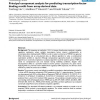602 search results - page 103 / 121 » Unsupervised Problem Decomposition Using Genetic Programming |
CEC
2010
IEEE
13 years 11 months ago
2010
IEEE
-- Design of non-uniform linear antenna arrays is one of the most important electromagnetic optimization problems of current interest. In this article, an adaptive Differential Evo...
KDD
2007
ACM
14 years 10 months ago
2007
ACM
A good distance metric is crucial for many data mining tasks. To learn a metric in the unsupervised setting, most metric learning algorithms project observed data to a lowdimensio...
IJBRA
2008
13 years 9 months ago
2008
Abstract Observing behaviors of protein pathways and genetic networks under various environments in living cells is essential for unraveling disease and developing drugs. For that ...
ICML
2007
IEEE
14 years 10 months ago
2007
IEEE
Maximum margin clustering (MMC) is a recent large margin unsupervised learning approach that has often outperformed conventional clustering methods. Computationally, it involves n...
BMCBI
2005
13 years 9 months ago
2005
Background: The responses to interleukin 1 (IL-1) in human chondrocytes constitute a complex regulatory mechanism, where multiple transcription factors interact combinatorially to...

